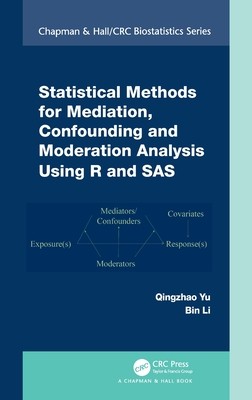
- We will send in 10–14 business days.
- Author: Qingzhao Yu
- Publisher: CRC Press
- ISBN-10: 0367365472
- ISBN-13: 9780367365479
- Format: 15.6 x 23.4 x 1.8 cm, hardcover
- Language: English
- SAVE -10% with code: EXTRA
Statistical Methods for Mediation, Confounding and Moderation Analysis Using R and SAS (e-book) (used book) | bookbook.eu
Reviews
Description
Third-variable effect refers to the effect transmitted by third-variables that intervene in the relationship between an exposure and a response variable. Differentiating between the indirect effect of individual factors from multiple third-variables is a constant problem for modern researchers.
Statistical Methods for Mediation, Confounding and Moderation Analysis Using R and SAS introduces general definitions of third-variable effects that are adaptable to all different types of response (categorical or continuous), exposure, or third-variables. Using this method, multiple third- variables of different types can be considered simultaneously, and the indirect effect carried by individual third-variables can be separated from the total effect. Readers of all disciplines familiar with introductory statistics will find this a valuable resource for analysis.
Key Features:
- Parametric and nonparametric method in third variable analysis
- Multivariate and Multiple third-variable effect analysis
- Multilevel mediation/confounding analysis
- Third-variable effect analysis with high-dimensional data Moderation/Interaction effect analysis within the third-variable analysis
- R packages and SAS macros to implement methods proposed in the book
EXTRA 10 % discount with code: EXTRA
The promotion ends in 17d.08:58:16
The discount code is valid when purchasing from 10 €. Discounts do not stack.
- Author: Qingzhao Yu
- Publisher: CRC Press
- ISBN-10: 0367365472
- ISBN-13: 9780367365479
- Format: 15.6 x 23.4 x 1.8 cm, hardcover
- Language: English English
Third-variable effect refers to the effect transmitted by third-variables that intervene in the relationship between an exposure and a response variable. Differentiating between the indirect effect of individual factors from multiple third-variables is a constant problem for modern researchers.
Statistical Methods for Mediation, Confounding and Moderation Analysis Using R and SAS introduces general definitions of third-variable effects that are adaptable to all different types of response (categorical or continuous), exposure, or third-variables. Using this method, multiple third- variables of different types can be considered simultaneously, and the indirect effect carried by individual third-variables can be separated from the total effect. Readers of all disciplines familiar with introductory statistics will find this a valuable resource for analysis.
Key Features:
- Parametric and nonparametric method in third variable analysis
- Multivariate and Multiple third-variable effect analysis
- Multilevel mediation/confounding analysis
- Third-variable effect analysis with high-dimensional data Moderation/Interaction effect analysis within the third-variable analysis
- R packages and SAS macros to implement methods proposed in the book


Reviews